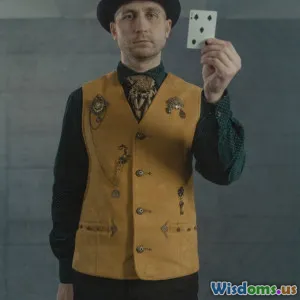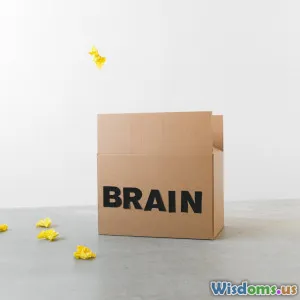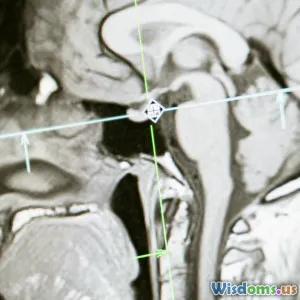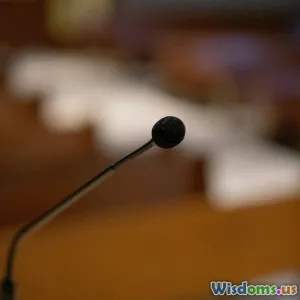
Inside the Art of Misdirection What Magicians Dont Want You to Know
8 min read Discover the secrets behind misdirection, the magician's craft that controls your attention and illusion. (0 Reviews)
Inside the Art of Misdirection: What Magicians Don't Want You to Know
Magic. An ancient art form deeply rooted in wonder, curiosity, and the impossible. But beneath the glimmers of sparkle and awe is a crafty practice that guides the audience’s eyes, thoughts, and beliefs: misdirection. Ever wonder how magicians seemingly perform the impossible without ever revealing their true method? The secret lies in the fascinating art of misdirection — a subtle control of human attention and perception.
What Is Misdirection?
Misdirection is the deliberate act of diverting an audience's attention away from a crucial action or object so that a magician can perform a hidden move undetected. Instead of relying purely on dexterity or gimmicks, it leverages human psychology — exploiting how we see and think.
Renowned magician and author Paul Harris once said, “Misdirection is not about fooling the audience; it is about guiding them.” This guiding shapes the entire performance, subtly coaxing viewers to look where the magician wants them to.
But misdirection is not merely gestural or visual. It taps into cognitive biases, expectation, and the limits of human focus.
The Psychology Behind Misdirection
The Limits of Human Attention
Human attention is a finite resource — we cannot consciously focus on everything around us at once. This limitation is a perfect playground for magicians.
Cognitive science shows that people typically attend to only one task or stimulus at a time in depth. Phenomena such as “inattentional blindness” demonstrate how individuals may completely miss obvious stimuli if attention is directed elsewhere. A famous example is the “invisible gorilla” experiment, where observers counting basketball passes in a video failed to notice a gorilla crossing the screen.
Magicians harness this by drawing your eyes and mind to something unassuming, while the real secret act happens peripherally or behind the scenes.
Pattern Recognition and Expectation
Humans are also pattern-oriented. We predict what will happen next based on past experience, allowing magicians to shape audience expectations and cleverly disrupt them at crucial moments.
This expectation is often manipulated through narrative structure or rhythmic timing, making the surprising moment sharper and more baffling.
Techniques of Misdirection
While magicians often innovate behind closed doors, certain classic strategies remain the foundation.
Physical Misdirection
This is the most visible form — using gestures, eye contact, or exaggerated movements to draw attention. For example, a flourish of the hand above a table distracts you while the other hand pockets a card.
Famous illusionist Harry Houdini excelled in physical misdirection, engaging spectators with one arm while the other executed deft maneuvers.
Psychological Misdirection
Less apparent but deeply powerful, it manipulates what the audience expects to happen:
- Verbal cues: The magician might tell a story or ask questions that shift your thought process.
- Timing: Introducing pauses and changes in pace to manage focus and release.
- Social engineering: Using your natural tendency to comply or infer intentions to guide your judgment.
Environmental Misdirection
The setting, lighting, and staging can guide attention subtly. Darkening one side of the stage while spotlighting another can funnel eyes away from a crucial action.
Real-World Examples of Misdirection
The Classic "Cups and Balls"
In this ancient magic routine, balls appear, disappear, and multiply beneath cups. The magician's hands perform multiple simultaneous motions — the audience is drawn to the conspicuous hand, while the other secretly hides or positions the balls.
The effectiveness relies heavily on mirroring audience gaze and using rhythmic timing to confuse perception.
David Copperfield’s Flying Illusion
Copperfield’s grand illusion where he appears to levitate leverages multiple layers of misdirection — the audience's focus is manipulated by sound, light, and the magician’s body language, while hidden harnesses and wires do their work unnoticed.
Close-Up Card Magic
Card handlers excel in micro-misdirections — slight finger gestures or shifting gaze keep your eyes glued in one place while sleight of hand creates impossible outcomes.
Why Magicians Prefer to Keep This a Secret
At its core, misdirection is a craft grounded in secrecy because revealing it would break the spell, destroying the experience of awe. If audiences fully understood every cue and psychological tease, threats to the illusion's effectiveness would rise dramatically.
Secrecy preserves mystery, richness, and engagement. In many ways, misdirection is an elaborate dance between performer and observer, one where the magician leads confidently without exposing the steps.
Lessons Beyond the Stage: Misdirection in Daily Life
Understanding misdirection extends beyond magic shows:
- Advertising: Brands often use misdirection by emphasizing certain features to distract from less attractive ones.
- Negotiations: Skilled negotiators direct attention to favorable terms while downplaying concessions.
- Personal Awareness: Recognizing misdirection sharpens critical thinking and media literacy.
A magician's secrets can empower us to see through manipulation, both entertaining and constructive.
Conclusion: The Art and Science of Seeing Beyond Illusion
Misdirection is much more than a magician's toolbox—it’s a sophisticated interplay of psychology, perception, and trust. By peering under the magician's cloak, we uncover the subtle ways our minds are steered, and once illuminated, the wonder evolves.
Rather than a simple cheat, misdirection is an artful performance of human cognition, one revealing just how enchanting and vulnerable our attention can be. Next time you marvel at a magic trick, remember: the real magic isn’t just in the hands, but in the elegantly guided focus of your own mind.
References:
- Kuhn, Gustav, et al. "The role of attention in magic and misdirection." Frontiers in Human Neuroscience, 2016.
- Macknik, Stephen L., et al. "Attention and awareness in stage magic: turning tricks into neuroscience." Nature Reviews Neuroscience, 2008.
- Lamont, Peter, and Cammaerts, Sofia. "Magic and memory: How misdirection works." Psychology of Consciousness, 2015.
Embrace the secrets, and maybe try a little misdirection of your own.
Rate the Post
User Reviews
Popular Posts




















